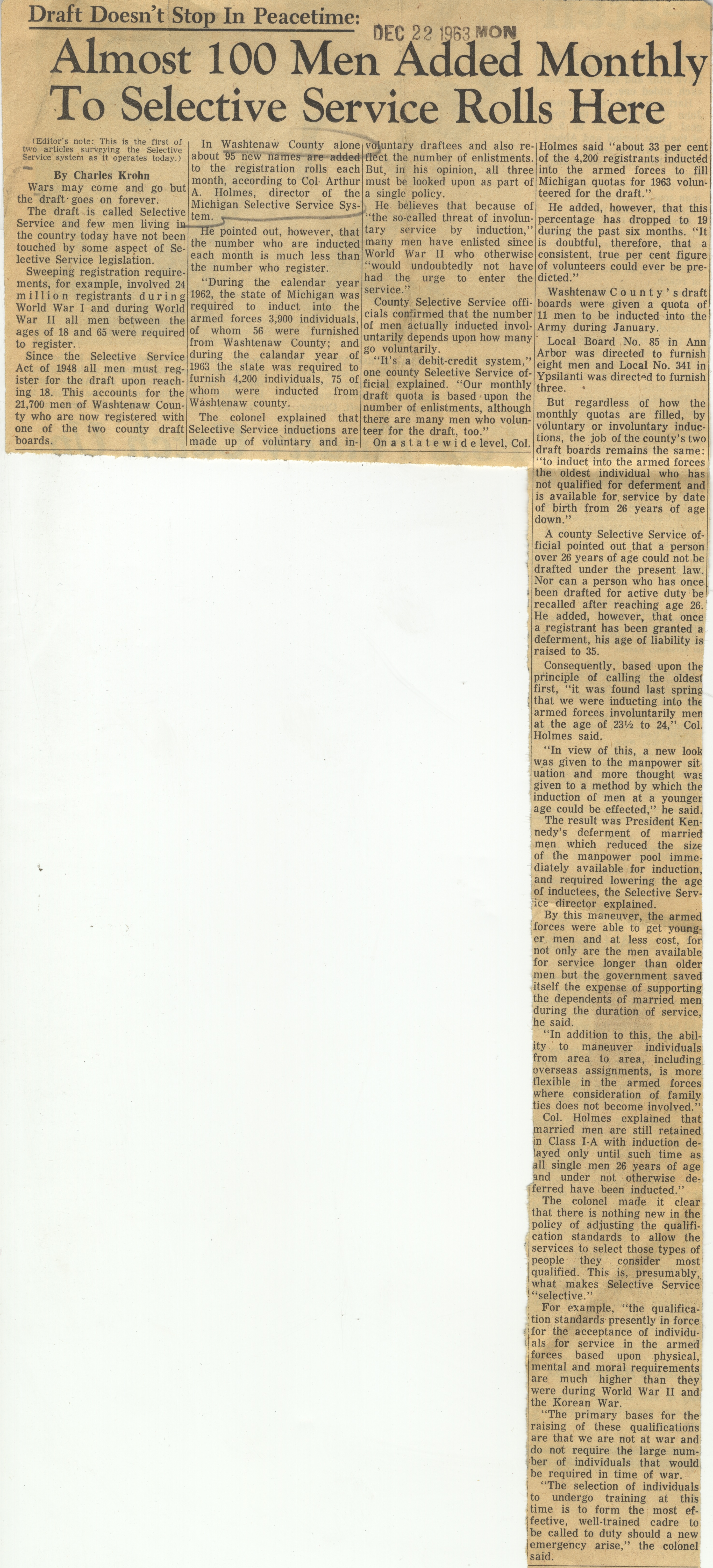Almost 100 Men Added Monthly To Selective Service Rolls Here

Draft Doesn’t Stop In Peacetime:
Almost 100 Men Added Monthly To Selective Service Rolls Here
(Editor's note: This is the first of two articles surveying the Selective Service system as it operates today.)
By Charles Krohn
Wars may come and go but the draft goes on forever.
The draft is called Selective Service and few men living the country today have not been touched by some aspect of Selective Service legislation.
Sweeping registration requirements, for example, involved 24 million registrants during World War I and during World War II all men between the ages of 18 and 65 were required to register.
Since the Selective Service Act of 1948 all men must register for the draft upon reaching 18. This accounts for the 21,700 men of Washtenaw County who are now registered with one of the two county draft boards.
In Washtenaw County alone voluntary draftees and also about 95 new names are added each month to the number of enlistments, according to Arthur A. Holmes, director of the Michigan Selective Service System.
He pointed out, however, that the number who are inducted each month is much less than the number who register.
“During the calendar year 1962, the state of Michigan was required to induct into the armed forces 3,900 individuals, of whom 56 were furnished from Washtenaw County: during the calandar year of 1963 the state was required to furnish 4,200 individuals, 75 of whom were inducted from Washtenaw county."
The colonel explained that Selective Service inductions are made up of voluntary and involuntary draftees and also reflect the number of enlistments. But, in his opinion, all three must be looked upon as part of a single policy.
He believes that because of “the so-called threat of involuntary service by induction," many men have enlisted since World War II who otherwise "would undoubtedly not have had the urge to enter the service.”
County Selective Service officials confirmed that the number of men actually inducted involuntarily depends upon how many go voluntarily.
“It’s a debit-credit system,” one county Selective Service official explained. “Our monthly draft quota is based upon the number of enlistments, although there are many men who volunteer for the draft, too.”
On a statewide level, Col. Holmes said “about 33 per cent of the 4,200 registrants inducted into the armed forces to fill Michigan quotas for 1963 volunteered for the draft.”
He added, however, that this percentage has dropped to 19 during the past six months. "It is doubtful, therefore, that a consistent, true per cent figure of volunteers could ever be predicted.”
Washtenaw County’s draft boards were given a quota of 11 men to be inducted into the Army during January.
Local Board No. 85 in Ann Arbor was directed to furnish eight men and Local No. 341 in Ypsilanti was directed to furnish three.
But regardless of how the monthly quotas are filled, by voluntary or involuntary inductions, the job of the county’s two draft boards remains the same: ‘to induct into the armed forces the oldest individual who has not qualified for deferment and is available for service by date of birth from 26 years of age down.”
A county Selective Service official pointed out that a person over 26 years of age could not be drafted under the present law. Nor can a person who has once been drafted for active duty be recalled after reaching age 26. He added, however, that once a registrant has been granted a deferment, his age of liability is raised to 35.
Consequently, based upon the principle of calling the oldest first, “it was found last spring that we were inducting into the armed forces involuntarily men at the age of 23 1/2 to 24,” Col. Holmes said.
"In view of this, a new look was given to the manpower situation and more thought was given to a method by which the induction of men at a younger age could be effected,” he said.
The result was President Kennedy’s deferment of married men which reduced the size of the manpower pool immediately available for induction, and required lowering the age of inductees, the Selective Service director explained.
By this maneuver, the armed forces were able to get younger men and at less cost, for not only are the men available for service longer than older men but the government saved itself the expense of supporting the dependents of married men during the duration of service, he said.
“In addition to this, the ability to maneuver individuals from area to area, including overseas assignments, is more flexible in the armed forces where consideration of family ties does not become involved.”
Col. Holmes explained that married men are still retained in Class I-A with induction delayed only until such time as all single men 26 years of age and under not otherwise deferred have been inducted.”
The colonel made it clear that there is nothing new in the policy of adjusting the qualification standards to allow the services to select those types of people they consider most qualified. This is, presumably, what makes Selective Service "selective."
For example, “the qualification standards presently in force for the acceptance of individuals for service in the armed forces based upon physical, mental and moral requirements are much higher than they were during World War II and the Korean War.
"The primary bases for the raising of these qualifications are that we are not at war and do not require the large number of individuals that would be required in time of war. “The selection of individuals to undergo training at this time is to form the most effective, well-trained cadre to be called to duty should a new emergency arise,” the colonel said.